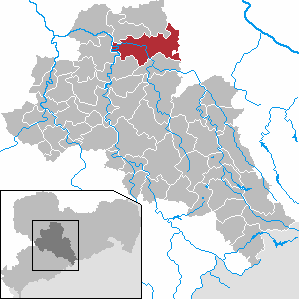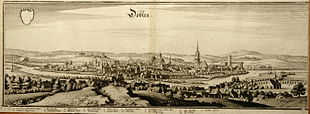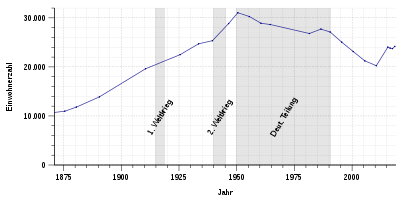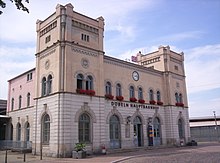Chub
| coat of arms | Germany map | |
|---|---|---|

|
Coordinates: 51 ° 7 ' N , 13 ° 7' E |
|
| Basic data | ||
| State : | Saxony | |
| County : | Central Saxony | |
| Height : | 168 m above sea level NHN | |
| Area : | 91.74 km 2 | |
| Residents: | 23,583 (Dec. 31, 2019) | |
| Population density : | 257 inhabitants per km 2 | |
| Postal code : | 04720 | |
| Primaries : | 03431, 034325 | |
| License plate : | FG, BED, DL, FLÖ, HC, MW, RL | |
| Community key : | 14 5 22 080 | |
| City structure: | 38 districts / 9 districts | |
City administration address : |
Obermarkt 1 04720 Döbeln |
|
| Website : | ||
| Lord Mayor : | Sven Liebhauser ( CDU ) | |
| Location of the town of Döbeln in the Central Saxony district | ||
Döbeln is a large district town in the Saxon district of central Saxony . It is also known as the boot city . Döbeln is the second largest city in central Saxony with around 24,000 inhabitants.
geography
Geographical location
Döbeln is located in the central Saxon hill country in a wide basin of the Freiberg Mulde , roughly in the middle of the triangle between the Saxon metropolises of Chemnitz , Dresden and Leipzig . The area is characterized by the Muldental, the lower Zschopau and the surrounding hilly landscape. The Zschopau flows into the Mulde near the Schweta district.
The state capital Dresden is around 50 km away, Chemnitz around 40 km, Leipzig 70 km and Berlin around 200 km. Döbeln has two motorway exits on the A 14 motorway , Döbeln Nord and Döbeln Ost.
Neighboring communities
Neighboring communities are Großweitzschen (district of central Saxony), Zschaitz-Ottewig (district of central Saxony), Lommatzsch ( district of Meißen ), Nossen (district of Meißen), the cities of Hartha , Roßwein and Waldheim (all district of central Saxony).
City structure
Döbeln has a traditional city center, the central part of which is on the Muldeninsel and is surrounded by two arms of the Freiberg Mulde.
|
Districts
|
|
|
history
The region around Döbeln has been Slavic , settled by Sorbs , since the 8th century . The name comes from the Old Sorbian word Doblin , which is derived from a person's name, Dobl .
The beginnings of German rule in the 10th century and subsequent settlement are associated with the Liudolfingers (also called Ottonians ), in particular with Heinrich I.
After 929, a former Slavic rampart on the castle hill was converted into a German fortification for Döbeln Castle , as the center of a castle wards that belonged to the Meissen region . At the foot of the castle hill there was a settlement that later became the town of Döbeln (1350 civitas ). A document from Emperor Otto II from 981 shows that he donated Doblin Castle and the surrounding land to Memleben monastery; it is about the large region between the Zschopau and the Große Striegis . This is the first documented mention of Döbeln (981).
Already in Slavic times there was a central rulership center in the Gau Daleminze . With the German settlement, German "administrative structures" ( feudal rule and Christianity with its institutions, the parish system and the official church ) were taken over. The German settlement of the place probably developed around 1200 to a communally constituted city (with certain own rights).
In 1350, for example, an independent districtus Döbeln is named, and in 1378 the castle and town are mentioned. In 1567 there is a report of a desolate mountain of the official castle. The reasons are not known, in 1588 the Döbeln office, which existed until then, was integrated into the Leisnig office . The castle, which had obviously fallen into disrepair for a long time, was no longer needed and was used to extract building material. From 1730 the keep was also demolished and between 1867 and 1869 the last remains of Döbeln Castle had to give way to the Schloßberg School.
At the foot of the mountain there is still the Nicolaikirche , the previous building of which was probably built around 1230. After a fire in 1333 a three-aisled basilica was built, which was converted into a three-aisled hall church in 1479 .
According to new knowledge, Döbeln was not visited by the Hussites in 1429 , but destroyed in 1450 by the Bohemians of Georg von Podebrady . Döbeln experienced great plague epidemics in the years 1439, 1463, 1474, 1507, 1515, 1584–1586, 1611–1626, 1637 and 1643. There were also serious city fires again and again (1333, 1419, 1429, 1456, 1488, 1523, 1611 and 1730), so that hardly any buildings from old times have been preserved. The town's handicrafts developed steadily up to the 17th century: cloth makers , linen weavers and hat makers were based here.
In the 3rd Silesian War ( Seven Years' War ), the battle near Döbeln was the only known military conflict in the immediate vicinity of the town of Döbeln. After Prussian and Austrian troops had dug themselves into the Freiberg Mulde between Technitz and Niederstriegis since autumn 1761 , the Prussians under Prince Heinrich of Prussia broke through the Austrian positions on the early morning of May 12, 1762 . The day ended with a complete victory for Prince Heinrich, large numbers of Austrian prisoners were taken, including the Commander-in-Chief General von Zedtwitz .
In the 19th century the old cloth making emerged into cloth manufacturing. The last cloth factory in Döbeln ended its existence before Christmas 1902 when production ceased. In 1846, cigar manufacturing was also started . In 1847 the Chemnitz-Riesaer Eisenbahn reached the city from Riesa , but the continuation of the connection to Chemnitz could not be opened until 1852. The Dresden – Döbeln – Leipzig line followed in 1868 . Since then, the Döbelner (main) station has been a wedge station . Furthermore, industrialization brought about the Oschatz – Mügeln – Döbeln narrow-gauge railway (from 1884), the Döbelner tram (from 1892, now a historic horse-drawn tramway ), the Großbauchlitz mill railway (1905) and the Wilsdruff-Döbeln narrow-gauge railway (around 1911).
At the end of the Second World War on May 6, 1945, the almost intact city was occupied by the Red Army .
During the floods in August 2002 , the historic city center, which is located on an island in the two arms of the Freiberg Mulde, was completely flooded and many houses were destroyed. The Muldeninsel and the other flooded areas have now been restored. In June 2013 the city was hit again by a flood of similar magnitude .
On August 1, 2008 Döbeln lost its function as a district town in the course of the district reform and was given the status of large district town in this context . The former district of Döbeln belonged to the administrative district of Leipzig , but the current district of central Saxony was part of Chemnitz until the establishment of the Saxony regional directorate on March 1, 2012 . On March 1, 2017, the 85-year-old Ruth K. was killed in a fire set by right-wing extremists in a prefabricated building district on the outskirts of Döbeln.
Documented forms of name
|
|
The name Döbeln goes back to a personal name dobl (a) or dobel (a) . Comparable word stems in Slavic languages mean strong, capable , also good .
Memorials
- Memorial stone in front of the crematorium of the cemetery for 21 Soviet and Polish women and men during the Second World War deported to Germany and victims of forced labor were
- One memorial each on Wettinplatz for Red Army soldiers by the sculptor Otto Rost and for all victims of fascism
- A memorial in front of the G.-E.-Lessing-Gymnasium to commemorate the victims of the First World War and the victims of "War, injustice and arbitrariness"
Incorporations
The villages of Küsten, Kleinbauchlitz and Sörmitz were incorporated into Döbeln in 1922, Großbauchlitz and Zschackwitz followed in 1932. In 1950 Gärtitz (with Pommlitz), Masten and Zschäschütz (with Bormitz) were incorporated, in 1967 Nöthschütz and 1974 Oberranschütz. Technitz was added in 1994. Ebersbach followed in 2011, and parts of the Ziegra-Knobelsdorf community in 2013 . On January 1, 2016, the neighboring community of Mochau was incorporated into Döbeln.
Population development
Development of the population (from 1960 December 31) :
|
Before 1900
|
1900 to 1979
|
Since 1980
|
Since 2000
|
politics
City council
Since the municipal council election on May 26, 2019 , the 26 seats of the municipal council have been distributed among the individual groups as follows:
| Party / list | Seats |
| CDU | 9 |
| AfD | 5 |
| SPD | 3 |
| LEFT | 2 |
| We for chub (WfDL) | 3 |
| FDP | 2 |
| FWV Döbeln (FWvDL) | 1 |
| GREEN | 1 |
Lord Mayor
The Lord Mayor is Sven Liebhauser (CDU). He was elected on May 26, 2019 with 65.7% of the valid votes for an initial term of seven years. He is an additional member of the city council and its chairman and head of the city administration.
coat of arms
Blazon : in gold a silver-grooved black battlement wall with three closed golden gates; on the wall three black towers of different shapes, each with two golden window openings, red roofs and golden knobs; a right-waving red flag between the towers.
Symbolism: The wall represents the former medieval city fortifications. The city gates symbolize the upper, lower and Staupitztor. The middle higher tower is supposed to point to the castle. The coat of arms has been valid in this form since 1992. The previous similar coat of arms, valid from 1894 to 1992, only had blue towers.
Town twinning
Döbeln maintains the following city partnerships :
- Givors in France ( Collectivité Territorial Metropolis Lyon ) since 1960
- Vyškov in the southeast of the Czech Republic since 1980
- Unna in North Rhine-Westphalia since 1989
- Heidenheim an der Brenz in Baden-Württemberg since 1991
Culture and sights
theatre
In Döbeln there is a venue for the Central Saxon Theater , which until 2008 also housed a youth theater ("Jugendtheater Döbeln eV").
Museums
The city museum was housed in the tower of the town hall on Obermarkt in 1997. The German Horse Railway Museum was opened in 2009.
Buildings
Döbeln is characterized by many restored town houses in the city center. The town hall on Obermarkt was built in 1912. Also worth seeing are the Schloßberg on the Muldeninsel and the late Gothic town church of St. Nicolai with its high altar and miracle man , whose historical origins go back to 1230. Other interesting buildings include the so-called Rotunda Building or Dome Building at the end of Burgstrasse, which was built in 1937/1938 for the metal and lacquerware factory Johannes Großfuß according to a design by the architect Wilhelm Kreis and is remarkable for its clear architecture. On the Staupitzberg, a 239.5 m high elevation on the outskirts of chub, is the under monument protection standing so-called Holländerturm , who in 1900 as a lookout tower was built. The 30 meter high tower owes its name to a Dutch windmill that used to stand next to its location , of which only the stump of the tower remains today. Next to the entrance to the former upper cemetery there is a royal Saxon post milestone on Dresdner Straße ( B 175 ) from the period from 1859 to 1865.
Since 2001 there has also been the boot fountain created by Vinzenz Wanitschke in the city . “Boot city” is called Döbeln because of the largest historical giant boot in the world up to 1996, which was made by Döbeln shoemakers in 1925 for the 600th anniversary of their guild with a height of around 4.60 meters. In 1937 it became the property of the town of Döbeln and was in the town hall and in the Wappenhenschstift town museum. It was often the main attraction at festivities in many cities, including the Leisniger Heimatfest in 1957. After its “last trip” to the 850th anniversary of the city of Zwickau in 1968, the boot remained on loan at the Mildenstein Castle District Museum. After a total of 53 years at Mildenstein Castle in Leisnig, it was installed on March 29, 2010 in the corridor of the 2nd floor of the Döbelner town hall. After the restoration of the giant boot, it can be found in the large meeting room of the town hall since 2012.
Regular events
In the "Boot City Döbeln" there are regular boot festivals at which boot parades are held. Once a year the boot queen is elected.
Limmritz Viaduct, part of the bankruptcy mile
Church in Technitz with graves in World War II Fallen
Economy and Infrastructure
traffic
Due to its central location in the middle of Saxony, different lines of three transport associations meet in Döbeln: MDV (Leipzig – Döbeln), VVO (Meißen – Döbeln) and VMS (other public transport lines). The Leipzig – Coswig and Chemnitz – Elsterwerda lines cross at the Döbelner Hauptbahnhof , each of which was served by DB Regio every hour. In December 2015, however, the train service in the section Döbeln Hbf – Meißen was canceled. The replacement buses (line 416) to Meißen only run a few times a day and are almost never used. Another alternative via Nossen is very unreliable, as the buses of the VVO line 424 use the often stowed A4 motorway. So far, politicians have not responded or responded negatively to demands to provide a direct connection to Dresden (as of September 2018). The clock was also thinned in the direction of Leipzig. The last train to Leipzig now leaves at 8:50 p.m. It is therefore impossible to reach cultural events in Döbeln in the evening by public transport. The federal highways B 169 and B 175 lead through Döbeln . The city can also be reached via the Döbeln-Nord and Döbeln-Ost (both on the A 14 ) and Hainichen Döbeln ( A 4 ) motorway junctions .
From 1892 to 1926, Döbelner Straßenbahn AG operated a 2.5-kilometer horse-drawn tram route from the main train station to the city center. An approximately 500 meter long section in the city center has been rebuilt. Since June 2007 a horse-drawn tram has been operating there again on special occasions.
hospital
The hospital is a standard care facility with 195 beds. In 1993 it was privatized and in 2010 the chief doctor took over the house.
Public facilities
Public facilities include a cinema, library, city museum, music school and some other cultural facilities.
Former garrison
From 1887 Döbeln was a garrison town for the Saxon Army , Reichswehr , Wehrmacht and National People's Army . The history of the Döbeln garrison ended in 1991 with the closure of the Paul Rockstroh barracks by the Bundeswehr .
Personalities
Honorary citizen
According to the resolution of the City Council 473/24/92 from 1992, the following honorary citizenships were confirmed:
- 1992: Johann Friedrich Wappenhensch, legal advisor
- 1992: Christian Beßler, surgeon
- 1981: Otto Simon, resistance fighter
- 1895: Otto von Bismarck , Reich Chancellor
- 1992: Friedrich Wilhelm Oehmichen , member of the Reichstag (awarded in 1874)
- 1992: Johann Gottlieb Böttger, city councilor
- 1992: August Julius Clemen, City Councilor
- 1992: Carl Schmidt, city councilor
- 1992: Otto Johnsen, head of the city council
- 1992: Ernst Heinrich Thiele, Mayor
- 1992: Heinrich Otte Wilsdorf, city councilor
- 1992: Carl Friedrich Lorenz, City Councilor
- 1992: Theodor Ehrlich, City Councilor
- 1992: Franz Richter, Councilor of Commerce
- 1992: Paul von Hindenburg , President of the Reich
- 1992: Robert Tümmler, Councilor of Commerce
- 1992: Paul Zieger City Councilor
- 1992: Wilhelm Berthold, chairman of the city council
- 1992: Otto Rost , sculptor
- 1992: Bernhard Kretzschmar , graphic artist
- 1992: Theodor Kunzemann, mayor
- 1992: Carl Schlegel, businessman
- 1992: Adam Ebert, banker
- 1992: Louis Sturm, manufacturer
Born in Chub
- Willy Anker (1885–1960), politician (SPD, KPD, SED) and resistance fighter against National Socialism
- Sixtus Braun (* around 1550-1614), town clerk, syndic and mayor of the city of Naumburg (Saale)
- Martin Hermann Büchting (1822–1885), Protestant theologian and author
- Michael Caelius (1492–1559), Lutheran theologian and reformer
- Johann Gottfried Clemen (1728–1785), plantation owner in Surinam
- Rüdiger Dohndorf (* 1950), politician (CDU)
- Thomas Gatzemeier (* 1954), painter, sculptor and writer
- Herbert Grötzsch (1902–1993), mathematician
- Emil Franz Hänsel (1870–1943), architect of the outgoing historicism and Art Nouveau
- Erich Heckel (1883–1970), expressionist painter
- Veit Heiduschka (* 1938), Austrian film producer
- Kurt Helbig (1923-2004), football player
- Henriette Hendel-Schütz (1772–1849), actress
- Abraham Hinckelmann (1652–1695), theologian and orientalist
- Sabine John (* 1957), track and field athlete and Olympic participant
- Wilhelm Kahlert (1877–1932), Vice Admiral of the Reichsmarine, head of the General Naval Office and Reich Commissioner of the Emden and Brake Maritime Offices
- Rainer Kirsch (1934–2015), writer and poet
- Benjamin Friedrich Köhler (1730–1796), hymn poet
- Bernhard Kretzschmar (1889–1972), painter and graphic artist
- Johannes Kromayer (1576–1643), Lutheran theologian and school reformer of Thuringia in the age of Lutheran orthodoxy
- Andreas Kunad (1602–1662), educator and Lutheran theologian
- Lars Kuppi (* 1971), policeman and politician (AfD)
- Friedrich Leipner (1896–1957), District Administrator in Pirna
- Karlheinz Liefers (1941–2006), director
- Egon von Neindorff (1923-2004), hippologist
- Richard Owe (1889–1970), politician (NSDAP)
- Karl Eduard Pönitz (1795–1858), military writer
- Hieronymus Prunner (around 1550 - 1606), Lutheran theologian, superintendent in Brandenburg an der Havel and provost in Berlin
- Werner Retzlaff (1890–1960), architect
- Gottfried Richter (1640–1717), organ builder
- Otto Rost (1887–1970), sculptor
- Horst Schade (1922–1968), football player
- Friedrich Herman Semmig (1820–1897), writer and teacher
- Johannes Uhlig (1899 – after 1989), botanist and teacher
- Paul Adolf Wagner (1868–1951), teacher, geologist and geography educator
- Julius von dem Bussche-Haddenhausen (1906–1977), politician (FDP)
- Werner Walde (1926-2010), politician (SED)
- Gert Wanka (* 1951), professor of applied mathematics
- Friedrich Weichelt (1894–1961), demolition engineer
- Johann Gottlieb Worm (1688–1735), world traveler to East India, Bengal, Persia
- Armin Zeißler (1922–2014), literary scholar, born in Limmritz
- Ulrich Zieger (1961–2015), writer
- Konstantin Ziegra (1617–1691), physicist and Lutheran theologian
Personalities who have worked on site
- Balthasar Balduin (1605–1652), pastor in Döbeln 1631–1636
- Adalbert Erlebach (1876–1945), architect
- Hermann Groine (1897–1941), NSDAP district leader in Döbeln since 1931
- Ernst Henrici (1854–1915), high school teacher, writer, colonial adventurer and anti-Semitic politician
- Gustav Hey (1847–1916), teacher and vice principal at the Realgymnasium von Döbeln
- Fritz Mierau (1934–2018), Slavist, translator, literary historian, editor and essayist, spent part of his childhood and youth in Döbeln and attended school there
- Arthur Pfeifer (1884–1976), educator and pacifist, from 1949 to 1954 teacher at Lessing Oberschule von Döbeln
- Johann Gottfried Sillig (1734–1792), deacon
literature
- Brigitte Abend, Ursula Resack: Portraits from the Döbeln district. Volume 1, Regio PR-Verlag, Dresden 2002, ISBN 3-932367-12-X
- Cornelius Gurlitt : Chub. In: Descriptive representation of the older architectural and art monuments of the Kingdom of Saxony. 25th booklet: Office governance Döbeln . CC Meinhold, Dresden 1903, p. 11 ff.
- Georg Dehio : Handbook of German Art Monuments, Saxony II, administrative districts of Leipzig and Chemnitz , Munich 1998, ISBN 3-422-03048-4 , pp. 190–197
- Carl Wilhelm Hingst : Chronicle of Döbeln and the surrounding area . Döbeln 1872 ( online ).
- A tradition from the Döbeln city court for the period 1631–1854 on court and local administration, criminal, civil and voluntary jurisdiction, church, school and feudal matters, replacements, court books and court records is in the Saxon State Archives, State Archives Leipzig, inventory 20603 City of Döbeln (City Court).
Web links
- Atlas Central Saxony
- City portal Döbeln
- Historical views of chub
- Chub in old views
- Topics of regional history around Döbeln, Döbeln Castle
- History about chub
Individual evidence
- ↑ Population of the Free State of Saxony by municipalities on December 31, 2019 ( help on this ).
- ^ Karlheinz Blaschke : History of Saxony in the Middle Ages . Berlin 1991, ISBN 3-372-00076-5 , p. 43ff
- ^ Ernst Eichler and Hans Walther : Saxony. All city names and their history , Faber and Faber Verlag, Leipzig 2007, ISBN 978-3-86730-038-4 , p. 53
- ^ MGH DD Otto II. 195. Digitized
- ↑ In the translation it says: "We (hand over) some castles and villages of our property in the Slavic area, namely Doblin and Hwoznie, in the Gau Daleminze (...) to the monastery of Memleben, which we founded and built." The monastery only existed until 1015, the property was transferred to the Hersfeld monastery on the Fulda . In the specialist literature one speaks of the Hersfeld own or the Hersfeld fief
- ↑ Max Kästner, Johannes Schiller: Between Chemnitz and Freiberg, A home book for school and house, The home soil and its colonization, Frankenberg 1928, p. 34
- ^ Karlheinz Blaschke , Uwe Ulrich Jäschke: Kursächsischer Ämteratlas 1790 . Gumnior Chemnitz, 2009, ISBN 978-3-937386-14-0 , p. 58
- ^ Georg Dehio : Handbook of German Art Monuments, Saxony II, administrative districts of Leipzig and Chemnitz, Munich 1998, ISBN 3-422-03048-4 , pp. 190ff.
- ↑ The silence after the fire [1]
- ↑ Ernst Eichler , Hans Walther (ed.): Historical book of place names of Saxony . Volume I, Berlin 2001, ISBN 3-05-003728-8 , pp. 188f
- ↑ a b Das Sachsenbuch, Kommunal-Verlag Sachsen KG, Dresden, 1943
- ↑ a b Municipalities 1994 and their changes since January 1st, 1948 in the new federal states , Metzler-Poeschel publishing house, Stuttgart, 1995, ISBN 3-8246-0321-7 , publisher: Federal Statistical Office
- ↑ Directories of the municipalities incorporated since May 1945 and evidence of the breakdown of the independent manor districts and state forest districts, 1952, publisher: Ministry of the Interior of Saxony
- ↑ a b State Statistical Office of the Free State of Saxony: Area changes
- ↑ Data source from 1998: State Statistical Office Saxony
- ^ Döbeln in the Digital Historical Directory of Saxony
- ^ Census results of October 29, 1946
- ^ Census results of August 31, 1950
- ↑ Municipal council election 2019. In: Election results. On Sachsen.de, accessed on December 10, 2019.
- ↑ Map services of the Federal Agency for Nature Conservation ( information )
- ↑ Holländer Tower on doebeln-enthaben.de
- ↑ www.stiefelbrunnen.de ( Memento of the original from July 19, 2013 in the Internet Archive ) Info: The archive link was inserted automatically and has not yet been checked. Please check the original and archive link according to the instructions and then remove this notice.
- ^ Article in the Sächsische Zeitung from September 8, 2010 on the change of ownership at the hospital
- ↑ 20603 City of Döbeln (City Court). In: State Archives Leipzig. Retrieved March 26, 2020 . (Info text on Döbeln city court under "Introduction")




























